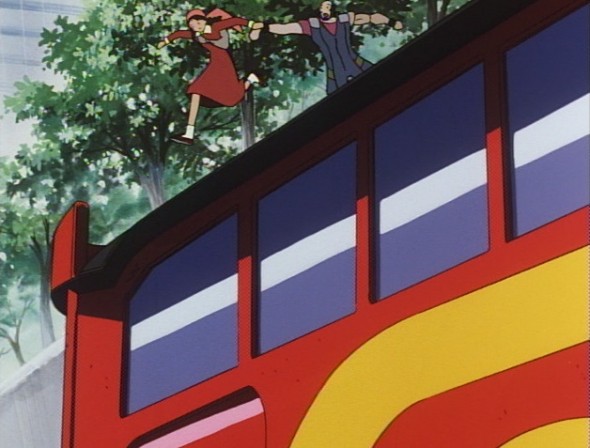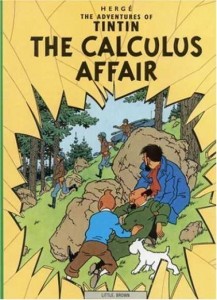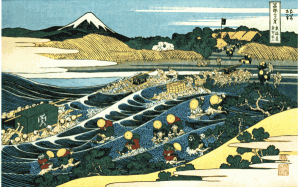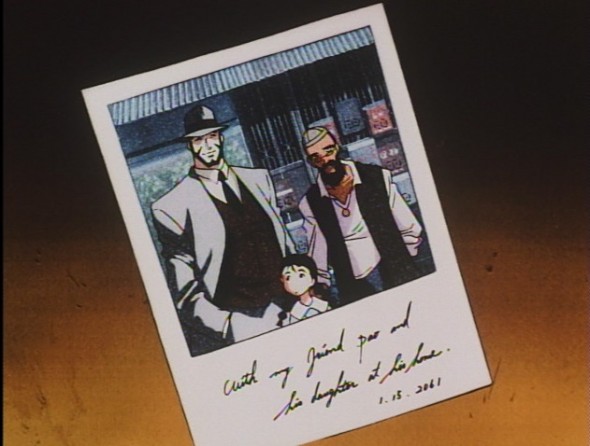

- Ligne-Claire?

Ligne-Claire.
Another drawback of looking for allusions everywhere is that sooner or later you’re going to start imagining connections that only exist in your head. “Boogie Woogie Feng Shui,” for me, is strongly, STRONGLY evocative of Hergé’s Tintin. There are a variety of reasons for this: first of all, there’s something ligne-claire-ish about the way it’s drawn; second, Jet falls pretty naturally into the Captain Haddock grumpy-protector role; and third, they jump onto the back of a speeding bus, which always struck me as the Tintin chase scene move par excellence. (And there’s also something less definable about the general mood.) But this connection seems frankly improbable: if the Cowboy Bebop people had wanted to make that kind of a reference, it probably would have been as overt as the Batman reference in Episode 20. If anything, I’m probably seeing the debt that both Hergé and Watanabe et al. owe to 19th century Japanese artists like Katsushika Hokusai. So I really don’t know what to do with this idea… I throw it out there on the off chance that one of you will be all like “DAAH! That’s what this episode reminds me of,” and also because it gives me a chance to point out that the Tintin books – despite their insidiously casual period racism, and despite the fact that they systematically and comprehensively fail the Bechdel test – are flipping sweet adventure stories.

- Ligne-Claire?
Actually, maybe there is more to it than that. Whether the mood of “Boogie Woogie Feng Shui” strikes you as Hergéian or not, it’s inarguably a departure from the mood of the series as a whole. It feels like a crossover episode, or a refugee from another series, maybe Tintin, maybe something else. (If you changed it so that the Sunstone led to a famous lost diamond mine, “Boogie Woogie Feng Shui” would make a bang-up episode of Duck Tales.) So part of why the episode feels a little funny, I think, is the fact that we’re basically seeing the finale of a series we never watched. Everything’s too compressed. Imagine it spaced over three years: the first season has Mei Fa receiving the luopan and gathering an unlikely band of companions; in the second season the enigmatic clue about the four gods leads them all over the solar system and results in dozens of wacky misadventures before they finally find the Sunstone in the two-part finale, ending with the cliffhanger realization that Pao might still be alive, and the third season has Mei Fa and company using the newly powered-up luopan to search for her father, finally realizing that what they need to do is take the sunstone into hyperspace near where he vanished and blast it with a particle beam, at which point Mei Fa’s tearful reconciliation with the dude could take place pretty much as written in the episode as it stands. That, to me, sounds like a pretty well plotted serial… but when you cram it into twenty minutes, it loses something. The introduction of Jet works fine, as does the later realization that Pao might still be out there pulling the strings, but the “finding the sunstone” sequence feels really odd. It’s pretty much hidden in the first place they look. I mean, yes, there’s a little montage of them looking a bunch of other places, but we never know why they looked in those places, or what wacky misadventures it led to, or – most glaringly – what eventually led them to the place where they eventually did find the stone. So even though they spend a fair amount of time looking in terms of fabula, in terms of sujet they basically just walk out and trip over the thing. Similarly, there should have been at least a few weeks of episodes built around the crew trying to figure out how to use the luopan to find Mei Fa’s father, then learning that they’d have to destroy the sunstone, and finally deciding that a chance at rescuing Pao justifies the destruction of their precognitive mojo. (The idea that they would need to blow up the stone to get to Pao makes total sense, in metanarrative terms, but because we see so little of them searching for it, and even less of them using it once they have it, it comes off less “cathartic sacrifice” and more “easy come, easy go.”)

- Poor anime characters. Just one hairstyle for their entire lifetime.
“By the way, this awesome orange color scheme is used nowhere else in the episode. In fact, the rest of it is pretty much blue, making it the extended version of that one obnoxious high-contrast color scheme they use in every single movie poster nowadays. Bebop did it before it was lame, though.”
I hope everyone is aware of this phenomenon. It’s quite striking. For an extensive gallery of examples:
http://www.slashfilm.com/2009/11/27/orangeblue-contrast-in-movie-posters/
Ah, I knew there was a gallery somewhere! I wanted to link to it but I couldn’t remember what website it was on. Thanks for that, Lee.
Although I’d call the trend more “damning” than “striking.” :-/
I can’t add anything here but I thought I would take out space and say that these articles are awesome.
Agreed. I love these articles and am really happy whenever a new one comes out.
8 pages?? F-yeah!
It’ll be a sad day when these are finished up and the series has been overthought. :D I hope you plan on doing the movie once the series is done!
One question I have about Spike’s “massive death wish.” It could be that, but I always figured Spike as a young guy to be an adrenaline junkie. He gets his thrills from dangerous situations. Unless that’s the same as a death wish. :D
I’ll probably do something about the movie… not sure quite what, though. I’ve been thinking a lot about how one could make Cowboy Bebop into a movie (because of the threatened live-action, all-Keanu-all-the-time remake), and I’m interested in how the show’s own creative team handled it. So one thought I had was to end my posts on the show itself with a list of dos and don’ts for a cinematic adaptation, and then watch the movie and see how it stacks up against that.
As for Spike’s death wish: I think at the beginning of the series, he comes off a lot more like an adrenaline junky (especially in the first episode, where he’s not interested in fighting Solensan until he realizes that the guy is nigh-indestructible), but that as the show goes on it seems more and more like he’s actually interested in finding his death, for a bunch of quasi-existential reasons. Before he goes off to fight Pierrot he actually says something like “Maybe this will finally be the one…” doesn’t he? He tries to play it off as a joke immediately afterwards, of course, but I don’t think we’re meant to believe him. I’ll go into this more in a future post, though. You bring up an interesting question.
MASSIVE SPOILER
*
*
*
*
*
*
*
*
*
*
The entire series is about death because, as we find out in the final series of episodes, Spike’s soul has basically been dead for years, and all that is left is for him to redeem his disgraceful life and die a Samurai’s death. Which of course he does.
Although, he’s marekd for death.
But, for real, the entire series is about redemption by chosing to die a good death.
In terms of Andy’s “death of cowboy identity”, what do you make of the end title reading “See You Space Samurai”? This might make the whole thing less a death than a transformation–Andy is still just as crazy, hokey and pseudo-cool as ever, he’s just swapped the superficial stereotype he’s imitating. (And even then, the cowboy stereotype arguably has a lot in common with the samurai one; you could argue that they’re similar archetypes.)
Anyway, awesome article!
I’ll see your “less a death than a transformation” and raise you a “what is death but a transformation?” When he hands Spike the hat and walks away, you’re supposed to think that his cowboy persona is dead (go ahead and put scare quotes around that if you want to). When he shows up as the samurai at the end, I find that it reads as a resurrection, or maybe a life-after-death, which amounts to pretty much the same thing.
The similarity of the cowboy and samurai archetypes is interesting, in that actual cowboys and actual samurai are about as different from each other as two groups of people have ever been. But in pop culture, they do seem to be functionally equivalent.